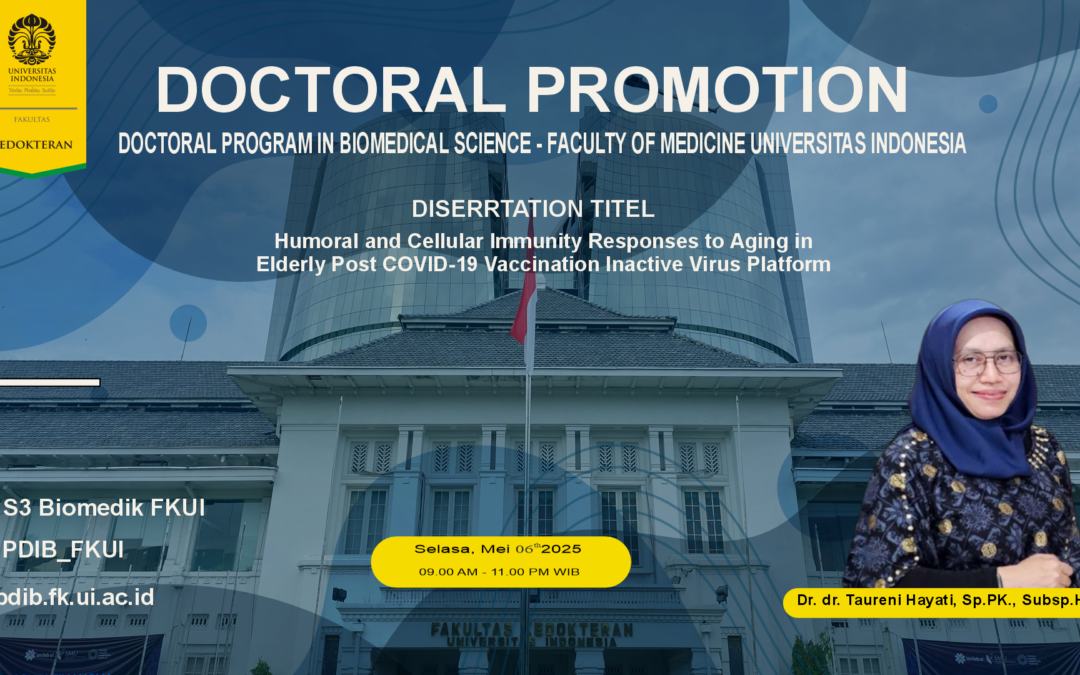Jakarta, April 6, 2025 – The Indonesian government through the Ministry of Health announced the start of the distribution of the latest phase of the COVID-19 vaccine as part of ongoing efforts to suppress the spread of the virus and protect the public. The vaccine used in this phase is a weakened or killed virus vaccine, so it cannot cause disease.To support scientific understanding of vaccine effectiveness, dr. Taureni Hayati., SpPK., Subsp. H.K(K) conducted a study on the immune response in the elderly after receiving the inactivated whole virus-based COVID-19 vaccine. This research was conducted at the Integrated Laboratory of the Faculty of Medicine, University of Indonesia (FKUl).
This study found a number of differences in the immune response between the elderly and young adults after receiving the second booster vaccine. The main findings include differences in humoral and cellular patterns.
1. Differences in Humoral Patterns
After booster vaccination, antibody patterns in the elderly differ from those in young adults, especially in the IgG4 and IgG3 antibody types. In the elderly, IgG4 levels increase, while IgG3 decreases. IgG4 plays a role in reducing inflammation and increasing immune system tolerance, thereby reducing the risk of excessive inflammatory reactions. In contrast, IgG3 plays a role in fighting infections and triggering inflammatory responses. Therefore, changes in these IgG subclasses can affect how the body responds to vaccines or infections. However, the ability of antibodies to neutralize viruses. no significant differences were found between the elderly and young adults. This indicates that the inactivated whole virus platform COVID-19 vaccine is still able to induce an adequate humoral response in the elderly, although there are changes in the distribution of IgG subclasses (increased IgG4 and decreased IgG3) which can affect the functional aspects of the antibody response.
2. Differences in cellular patterns
In the elderly group, there are indications that inactivated vaccines are less effective in activating several components of cellular immunity, especially related to CD8+ T cells. However, activation in CD 4+ is no different from young adults. The less effective activation of CD 8+ is indicated by the absence of an increase in naive T cells and the persistence of the sensing T cell population (aging). This can have an impact on decreased effector functions such as cytokine production and cytotoxicity, which can affect the capacity to eliminate the virus. This study is supported by cytokine mediators that are not as optimal as the young adult group, especially the IFN-γ response, and IL-6. While the cytokine mediators of TNF-a, IL-2 and IL-10 do not differ between the elderly and young adults.
Implications and Expectations
Overall, these findings indicate that COVID-19 vaccination with an inactivated whole virus platform in the elderly produces adequate humoral and cellular immune responses for protection, but with a different pattern from young adults due to the influence of immunosenescence. These differences may have implications for the duration of protection and response to different virus variants, which needs to be further investigated in long-term longitudinal studies.
“The results of this study show changes in the pattern of immune response with aging, which is important to consider in vaccination strategies, especially for the elderly population. The formulation of elderly vaccination policies needs to consider the results of this study in determining more effective vaccination strategies, including the possibility of using special vaccines for the elderly. Periodic monitoring and evaluation of the effectiveness of elderly vaccination is needed to adjust the optimal booster strategy.
This study is expected to be an important reference for the development of a more specific and effective COVID-19 vaccination strategy for the elderly group, considering the differences in immunological characteristics they have compared to younger age groups.

